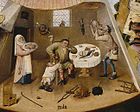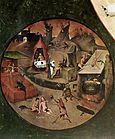The Seven Deadly Sins and the Four Last Things
| The Seven Deadly Sins and the Four Last Things | |
|---|---|
 | |
| Artist | Hieronymus Bosch |
| Year | around 1500 |
| Type | Oil on wood |
| Dimensions | 120 cm × 150 cm (47 in × 59 in) |
| Location | Museo del Prado, Madrid |
The Seven Deadly Sins and the Four Last Things is a painting that has traditionally been attributed to Hieronymus Bosch, completed around 1500 or later. Since 1898 its authenticity has been questioned several times. The painting is oil on wood panels and is presented in a series of circular images.
Four small circles, detailing the four last things — "Death of the Sinner", "Judgment", "Hell" and "Glory" — surround a larger circle in which the seven deadly sins are depicted: wrath at the bottom, then (proceeding clockwise) envy, greed, gluttony, sloth, extravagance (later replaced with lust), and pride, in scenes from life rather than in allegorical representations of the sins.[1]
At the centre of the large circle, which is said to represent the eye of God, is a "pupil" in which Christ can be seen emerging from his tomb. Below this image is the Latin inscription Cave Cave Deus Videt ("Beware, Beware, God Sees").
Above and below the central image are inscription in Latin of Deuteronomy 32:28-29, containing the lines "For they are a nation void of counsel, neither is there any understanding in them", above, and "O that they were wise, that they understood this, that they would consider their latter end!" below.
Discipulo
In 1560 Felipe de Guevara wrote about a pupil of Bosch, a "discipulo", who was as good as his master and even signed his works with his master's name.[2] Immediately after this, and without starting a new paragraph, de Guevara refers to the painting of the Seven Deadly Sins as characteristic of his style. This brought some scholars, as early as Dollmayr (1898) and most vocally by Stechow (1966), to ascribe the work to this pupil. Most experts have argued since, however, in spite of the context, that de Guevara had returned to a description of the works of Bosch himself. For a considerable time, therefore, the painting was considered to be a work from Bosch's early period. The attribution to the discipulo was revived in the catalogue of the 2001 Bosch exhibition in Rotterdam), by Vermet and Vandenbroeck, who also suggested that several of the costumes suggest a much later date, around 1500, so that the awkward drawing and execution cannot be attributed to youthful imperfection, and that the painting was not on oak, all adding to their doubts about the attribution to Bosch.[3]
Historian Ed Hoffman in 2005 concluded that the amateurish style, the plump figures, the lack of white highlights and the fact that the panel is not a painting on oak but poplar or cypress wood argued for the work being a copy, perhaps ordered by Philip II of Spain after the original had become damaged. An argument for the authenticity, or at least originality, of the work could be found in the pentimenti of the underpainting, which indicate it could not have been a simple faithful reproduction.[4]
In October 2015, the Bosch Research and Conservation Project,[5] which had been responsible, since 2007, for technical research on most of Bosch's paintings, confirmed that they had rejected the attribution to Bosch and that they considered it to be made by a follower, most likely the discipulo.[6] In a reaction, the Prado Museum stated that they still consider the piece to be authentic.[7]
Content
Each scene in the painting depicts a different sin. In the Pride scene, a demon is shown holding a mirror in front of a woman. An enraged a man is about to kill a woman, symbolizing murder as an effect of Wrath.
The four small circles also have details. In Death of the Sinner, death is shown at the doorstep along with an angel and a demon while the priest says the sinner's last rites, In Glory, the saved are entering Heaven, with Jesus and the saints, at the gate of Heaven an Angel prevents a demon from ensnaring a woman. Saint Peter is shown as the gatekeeper. In Judgment, Christ is shown in glory while angels awake the dead, while in the Hell demons torment sinners according to their sins.
Details
Seven Deadly Sins
-
Wrath (Ira)
-
Pride (Superbia)
-
Lust (Luxuria)
-
Sloth (Accidia)
-
Gluttony (Gula)
-
Greed (Avaricia)
-
Envy (Invidia)
Four Last Things
See also
- Rota Fortunae
- Bhavacakra, a similar diagram in Buddhism
References
- ^ Claudia Lyn Cahan and Catherine Riley (1980). Bosch~Bruegel and the Northern Renaissance. Avenal Books. ISBN 0-517-30373-6.
- ^ Felipe de Guevara (1560), Commentarios de la Pintura. English summary and commentary in: Stechow, Wolfgang, (1966), Northern Renaissance Art 1400-1600: Sources and Documents (paperback 1989, pp. 19-20).
- ^ Koldeweij, J., P. Vandenbroeck, J. and Vermet, B. (2001), Jheronimus Bosch: The complete paintings and drawings, Harry N. Abrams, ISBN 978-0810967359, pp. 93 and 178.
- ^ Ed Hoffman, 2005, "Een echte 'Jheronimus Bosch'? : Tien aandachtspunten", Bossche Bladen 3: 90-96
- ^ boschproject.org
- ^ Twee beroemde werken toch niet van Jeroen Bosch, NOS, 31 October 2015
- ^ Ferrer, Isabel (1 November 2015). "¿Pintó El Bosco los 'pecados' de El Prado?". El País.
El Museo del Prado, de Madrid, por el contrario, cree que la tabla sí es del artista, y sus propias conclusiones aparecerán en mayo, cuando la exposición viaje a Madrid. [The Museo del Prado, Madrid, by contrast, believes that the table itself is by the artist, and their own conclusions appear in May when the exhibition travels to Madrid.]











